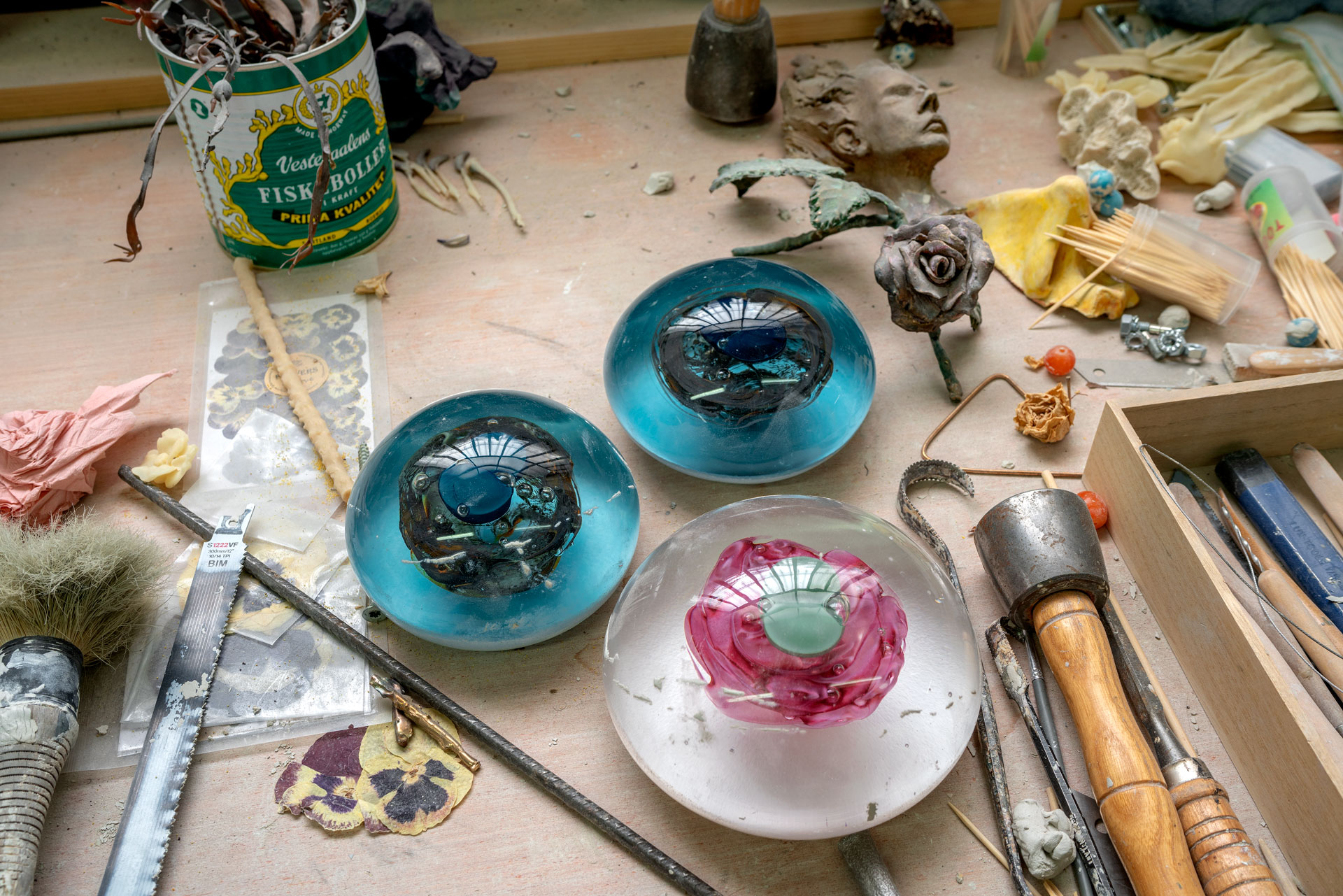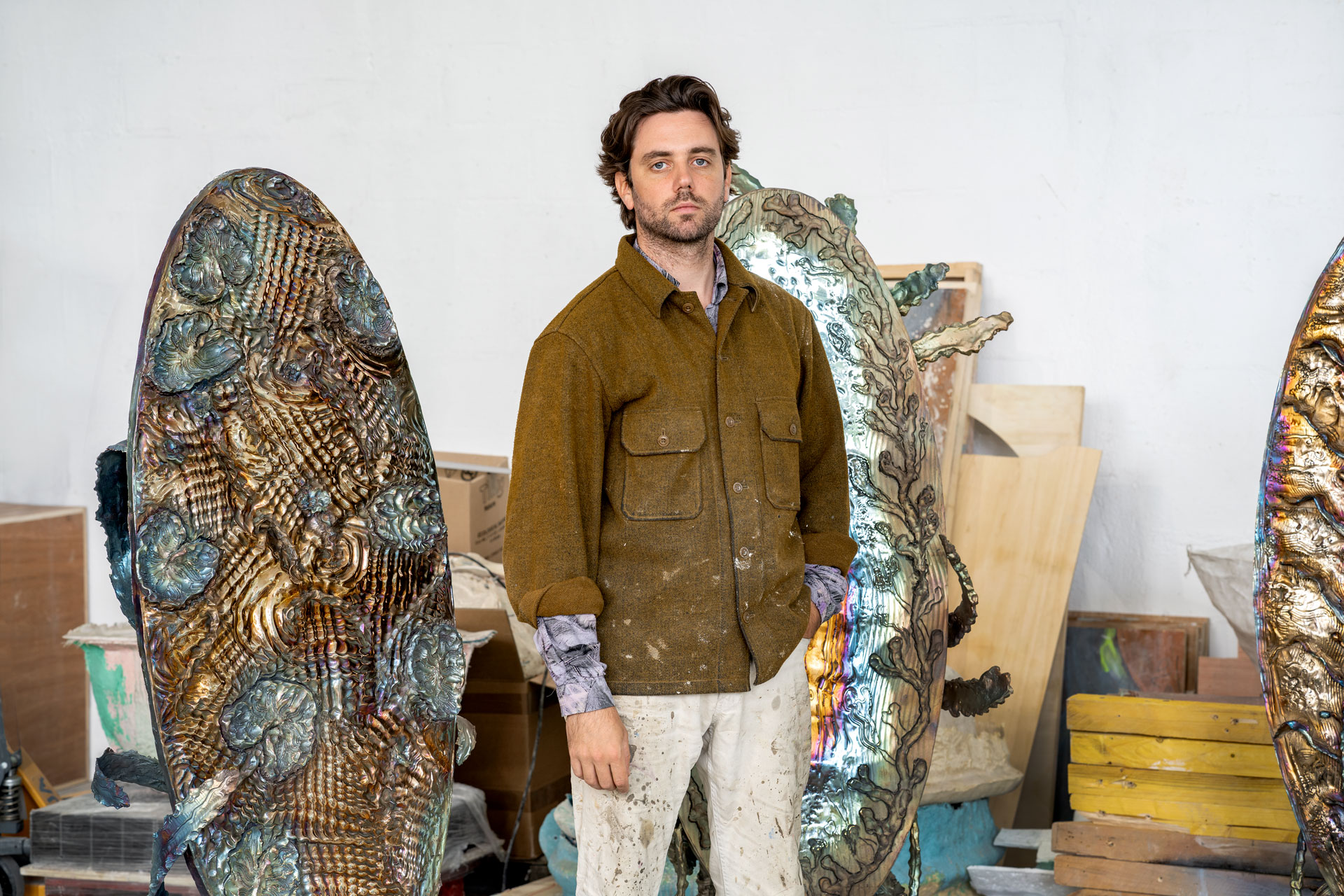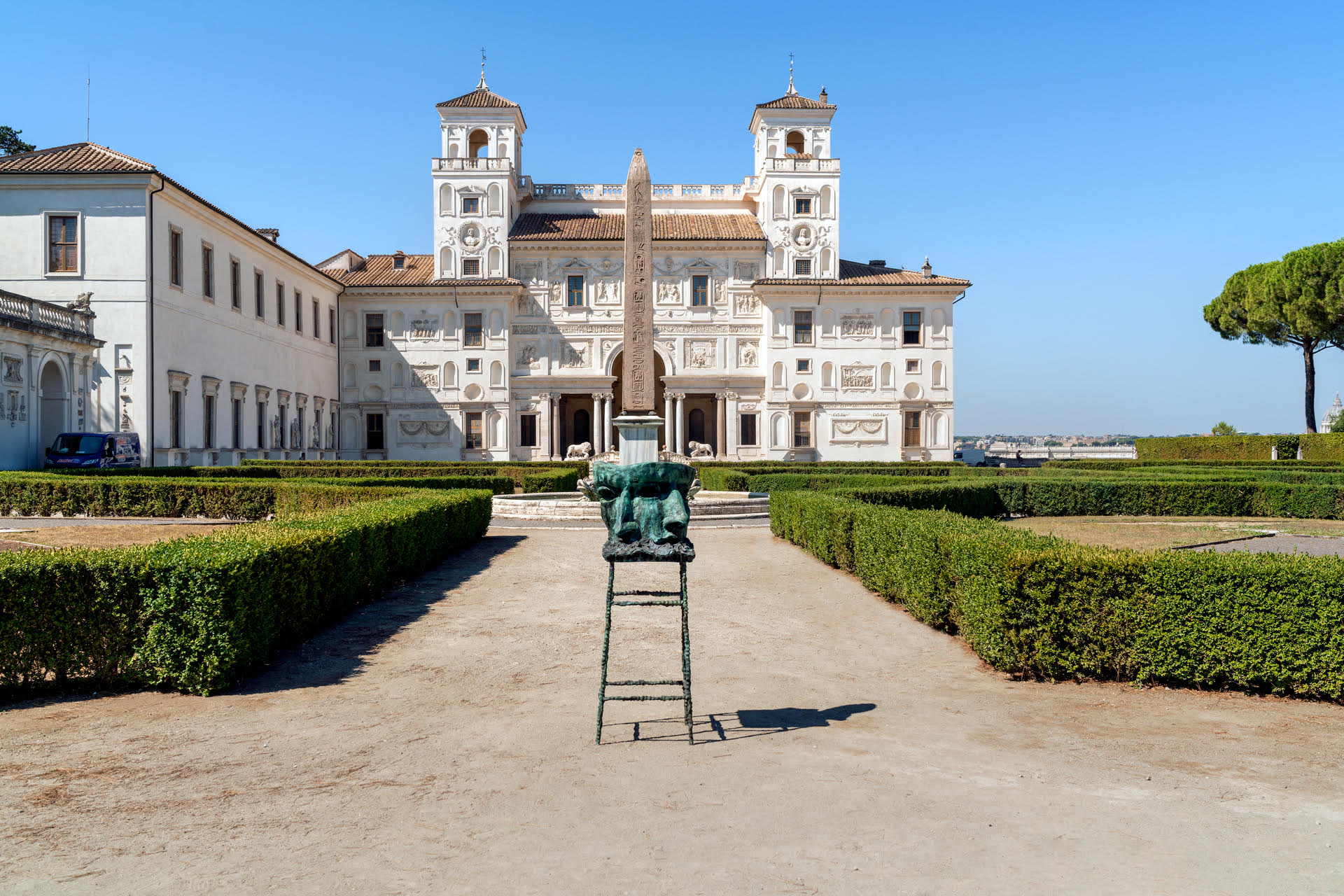
Three standing mirrors with layers of organic aquatic lushness instead of glass and silver reflect Jean-Marie Appriou’s high-ceilinged studio in Paris. Not far away, a crescent shaped river boat with a cyclopic figurehead has found a safe refuge near a corner where delicate bronze reeds form a little riverbank.

Rising tall by the window are the two elegant white dromedaries that stand on their mirror image and silently overlook two bronze flamingos and the artist at work, his long rectangular worktable filled with clay models, bizarre glass objects, and carving tools.



“The reeds, the mirrors, the boat, the cyclopic faces, the animals, the pink flamingo …even details of a ruin at the back of a palace… all those are things that we see in Gustave Moreau’s paintings,” says Appriou who finds inspiration in Moreau’s painterly world. In fact, he often visits the French symbolist’s house and atelier now turned into a museum just to be immersed in his universe. “It is very moving being at his place, even if it is set up in a museum.”

The mirrors, a new series of sculptures he is working on, are embellished with ornamental seaweed details, like the ones we find in marshes, and water lilies that look like floating hearts. “But they are not mirrors to look at ourselves in, but rather mirrors that bring forth the light.” Their bronze, bluish and yellow palette is magnetic, like the Cyclops that decorates the bow of the boat.

This Cyclops is inspired by a painting by Odilon Redon, in which the Cyclops Polyphemus softly gazes from behind a rocky mountain at the sleeping Nereid Galathea. “It’s not really the story of Homer. It’s not really the story of Ulysses that interests me to describe. It’s rather what it can convey and what we can still look for in our time in its founding myths. What is still there and what is not yet there but what can I do with it in 2022.”
Sculpting the Cyclops is an attempt for him to communicate with the people of the past, “a journey not in the archaeological sense but more of a sentimental journey in time.” And to do that he uses earth’s most primal element, clay. “In French ‘terre’ is the same word which you use for the ground, the material and the planet, and I think it’s really something if you take a piece of the world and you make something out of it, an expression, and then it goes back.”
In French ‘terre’ is the same word used for the ground, the material and the planet, and I think it's really something to take a piece of the world and make something out of it, an expression, and then it goes back.
Jean-Marie AppriouWhat especially interests him is when clay disappears, and he is quick to point out that many of Auguste Rodin’s original clay models have disappeared. “It is like a dream that escapes.” What remains is the impression that the foundry has cast in metal. “This is the memory of this earth, but it is not the original model; what was touched by the artist is left in the cosmos.”

And when he says cosmos, he probably means astral travel and refers to the aluminium boat that was installed over the summer in Villa Medici, one of ten site-specific interventions in the heritage site. “This material makes one think of a space shuttle or a satellite in orbit,” says Appriou his senses expanding in outer space and to the idea of travel, not only in a physical sense. “What I like very much in the Egyptian boats is that they are symbolic boats used to cross the Nile, crossing in a way that is also psychic. It is the crossing from the world of the living to the world of the dead; it is the crossing of the soul; it is the course of the sun.”

The aluminium boat at the Villa Medici features a figurehead of Ophelia, the tragic character from Hamlet who, driven mad by her lover’s murder of her father, stumbles into a river and drowns. Through her, Appriou has repeatedly investigated the tensions between the conscious, the unconscious, and the subconscious. “I find that the boat is this very beautiful thing. It is a space made to contain, to float on another matter, and at the same time, it has the sail that inflates to be the image of the void really. It is about the spaces between the things.”

And this in between state is what he wished to capture in a new sculpture of Ophelia that he created for Massimo de Carlo’s new London gallery. Her hair is sculpted like a halo crown piece around her head and the water ripples like a necklace of water lilies around her neck. “The sculpture seems to levitate; she is floating as if she were an astronaut in space. She is singing at the same time she is drowning. Two forces that are against each other.”

Like a film still prior to her drowning, the bas-relief he displayed in the Villa Medici’s Gypsotheque depicts Ophelia sitting on a riverbank. Only her lower body is immersed in a river that reflects her figure and the branches of a willow tree. It is not Ophelia’s death that interests Appriou but that it became a subject of interrogation for the Pre-Raphaelites. “It’s really the passage from Ophelia’s death, which doesn’t occur on stage in Hamlet, to something that is seen, something that is reported by the queen, something that people might have seen. But we don’t really know either what happened.”

John Everett Millais illustrated the scene in his emblematic Ophelia, and Appriou often contemplates that painting. Looking at it he is impressed by the plasticity of Ophelia’s dress, “at once her savior as it balloons in the water and at the same time the cause of her death, her mise en abyme,” and also by the secret symbolism of each flower that in the painting is depicted in full bloom.

Ophelia is not the only character that appears regularly in his practice. “I often use the metaphor of theater to explain; I try to act like a director. I take a body, as if I were casting it, and say to myself in the workshop: here, you will be the astronaut, you will be the bee-keeper, you will be the Ophelia, these are the characters that come back.”
The cosmonaut, a character he has been using since 2016, landed last summer in Villa Medici and was directed to gaze at the sky through his glass red helmet while pretty flowers bloomed on his astral golden body. But the Villa also set the stage for the introduction of a new character, the shaman. The shaman is a hypnotized striding figure, in seahorse attire. “He is inhabited by… almost the spirit of an animal, in this case the hippocampus.”
Appriou wants his characters to inform one another and likes to weave stories between them. “I think of it like a pearl necklace… at the end, it composes a story together.” So there was nothing accidental in the way he aligned the shaman with astronaut. “The shaman was something that gave direction to a dream that drew to a close with the astronaut; it’s like the world can look at his shuttle at the end.”
For a different installation, the beekeeper carried the astronaut on his back. “I like the word keeper in English. It is quite beautiful…bee-keeper, the keeper of the bees. He takes care of, rather he is the guardian of what is past or what is, in any case, terrestrial and current, while the astronaut is the child, a metaphor for the future.”



The keeper of bees brings to mind the wide range of animals that Appriou has created, like the seal that floated serenely in Villa Medici’s Bird Room, or the fish that glided in the Aurora Room, or the lion heads in the square of the Niobides. These delighted and surprised the audience, but also the artist himself. “If I am allowed to say, the Villa has been a playground, so rich in inspiration that I could come up with different things every year for a new show.”

With the same enthusiasm and curiosity, he talks about the dromedaries standing on their reflections in his studio as if they were the key to an expanded consciousness. “What interests me is to go beyond this imaginary surface that the mirage, or the world, is. This Alice in Wonderland or William Blake trick of the passage. The door to another state. When we are in front of a work of art, we don’t know what happens, it is indescribable, but we pass through a door to a state of superior consciousness.”
His bronze flamingos trigger creativity. “When you understand that the flamingo is pink because it eats shrimp, or when you think of how wild birds travel from the North to the South as if they had an internal compass, everything is mystical. It does things in the head, it opens the imagination, because we say that we can apply that to the human being, we can apply that to many things and that really. … opens up plastic possibilities.”

Appriou’s passion is not confined to the natural world, but also extends to history and antiquity. He sounds playful when he says, “the sculpture in Villa Medici’s Cleopatra Loggia is surely a Venus, who in ancient Greece was Aphrodite, who in the Roman Villa becomes Cleopatra. It’s like a collage.” His work operates in the same way, blurring things, eras, and references. To complement the ancient beauty in the Villa, Appriou installed a cagelike rose structure, drawing inspiration from Edward-Burne Jones’s painting The Rose Bower that illustrates a scene from the fairy tale Sleeping Beauty. “The beauty is asleep together with all the other people in the castle as in the Disney movie. There are huge brambles like barbed wire that protect and put the castle under seal.”


The scene in the Loggia Cleopatra “that has the ruin (something of the past), the brambles (something of the present) and the wasteland (something of the future)” is a metaphor for time as is the sculpture he placed in front of the Villa’s Egyptian obelisk. The aquatic creature emerging from the water, “a bit like a rocky cliff,” is Appriou’s version of the two-faced Roman god Janus, the god of beginnings, gates, transitions, time, duality, doorways, passages, frames, and endings.

Rome and Paris, 2022. All photos © Alexia Antsakli Vardinoyanni www.artflyer.net





